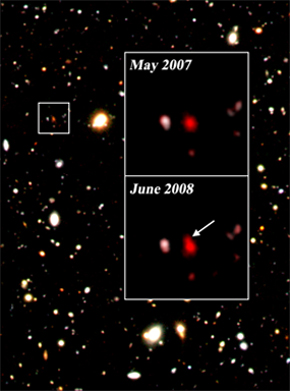
|
The deeper you gaze out into space, the further you see back in
time. That is why a group of astronomers observed the Subaru Deep
Field, a patch of the sky the size of the full moon, using the 8.2-m
Subaru Telescope in Hawaii. They “stared” with the telescope at this
patch for two nights at a time, collecting the faint light from over
150,000 galaxies that become visible in this small region at such
image depth. Why so many galaxies? In order to hunt for supernovae,
the colossal explosions of dying stars. The team found a total of
150 supernovae, including 12 of the most ancient ever seen, having
exploded 10 billion years ago, with their light reaching us now.
So-called Type-Ia supernovae are major producers of the element iron in the Universe,
and are useful for measuring cosmological distances.
In this latter context, they were used over the past decade to discover the accelerating expansion of the Universe,
for which the 2011 Nobel Prize in Physics has just been anounced.
The present team of researchers was able to show that such supernovae exploded 5 times
more frequently than today when the Universe was only about
one-third its current age. Tracking how the frequency of these
explosions changed as the Universe evolved is important for
reconstructing the cosmic history of element production, and for
understanding the explosions themselves.
The image to
the left shows one of the most ancient supernovae ever discovered,
having exploded 10 billion years ago, more than 5 billion years
before our solar system was formed. |